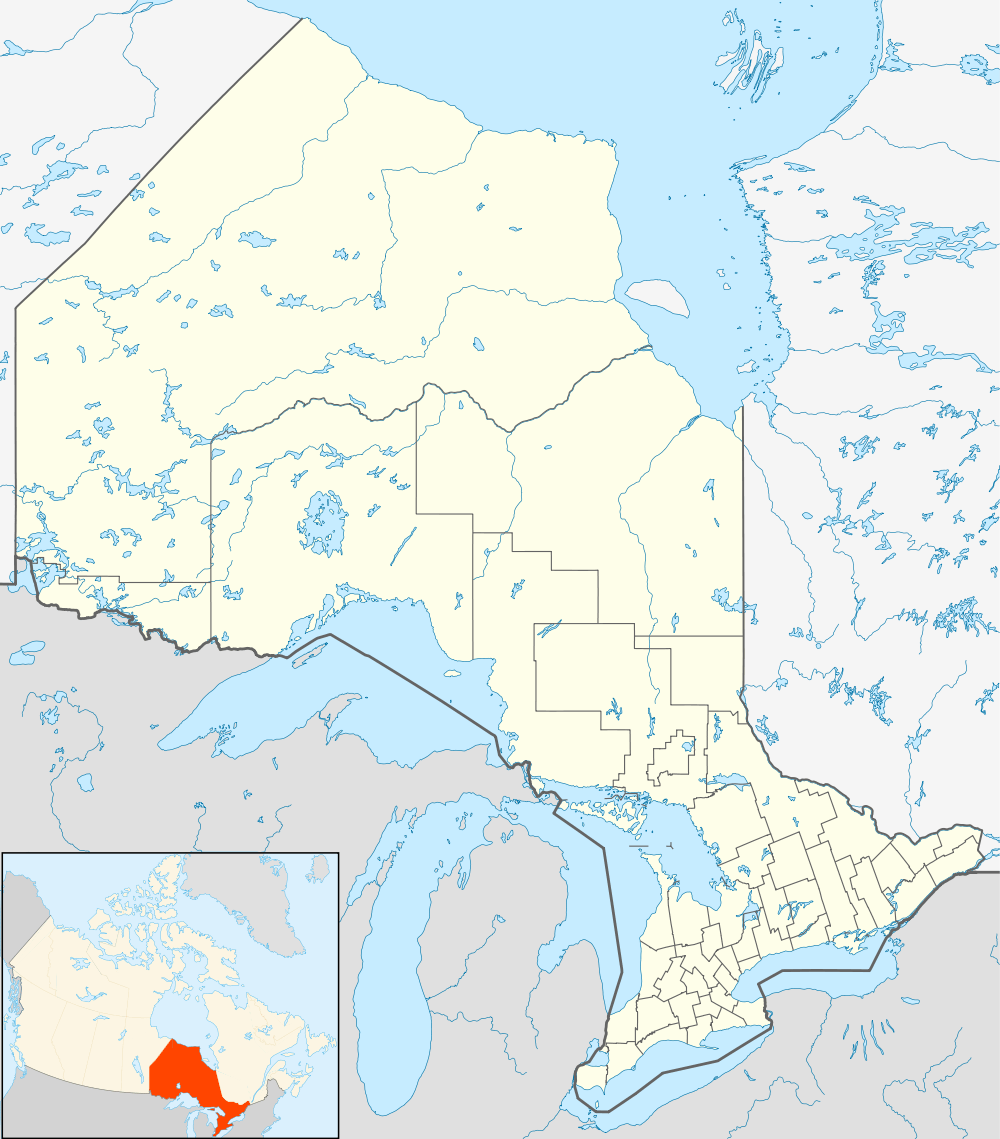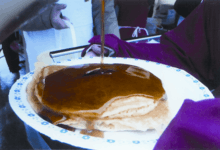Elmira, Ontario
| Elmira | |
|---|---|
| Unincorporated community | |
 | |
 Elmira Location within Ontario | |
| Coordinates: 43°35′36″N 80°33′45″W / 43.59333°N 80.56250°WCoordinates: 43°35′36″N 80°33′45″W / 43.59333°N 80.56250°W | |
| Country | Canada |
| Province | Ontario |
| Regional municipality | Waterloo |
| Township | Woolwich |
| Settled | 1798 |
| Time zone | EST (UTC-5) |
| • Summer (DST) | EDT (UTC-4) |
| Forward sortation area | N3B |
| Area code(s) | 519 and 226 |
| NTS Map | 040P10 |
| GNBC Code | FEHOW |
Elmira is the largest community within the Township of Woolwich in the Regional Municipality of Waterloo and is located 15 kilometres (9 mi) to the north of the city of Waterloo in Ontario, Canada. The community was listed as a population centre in the Canada 2011 Census, with a population of 9,931 living in the community.[1]
History
While the land comprising Woolwich Township originally belonged to the Huron followed by the Mohawk Indians, the first settlers arrived in Woolwich Township in the late 18th century. In 1798, William Wallace was one of the first settlers in the area after he was deeded 86,078 acres (348 km2) of land on the Grand River for a cost of $16,364. Originally Block three of Indian Lands, this area now comprises a large part of Woolwich Township. The parcel of land called "Woolwich' was named in honour of a government surveyor.
In 1806, Wallace sold the major portion of his tract to Mennonites. Benjamin Eby, the secretary of the Germany Company had come to the area, along with his friend Henry Brubacher. On a tour of exploration, the young men wandered into Wallace's Woolwich. Enamoured by the country, Eby formed a land company in Pennsylvania. The following year, he returned with a barrel of silver dollars, plus prospective settlers - the Musselmans, Martins, Hoffmans, and Gingerichs. Wallace sold the Germany Company 45,185 acres (183 km2) of land at $1.00 an acre. On May 1, 1807, Eby received the deed and the release of the mortgage. Woolwich Township gained recognition as an official township in 1816.

In 1834, Edward Bristow became one of Elmira's first settlers when he purchased 53 acres (210,000 m2) of land at this location for 50 cents per acre. A community by the name of Bristow's Corners was already in existence in 1839 when a post office was assigned there. Local merchant Samuel Weber had been visiting New York State in the early 1850s and was apparently impressed with Elmira, New York. This may have been a factor in the decision of Woolwich Township council on February 22, 1853 to rename the community Elmira. In the 1850s, German settlers moved into the community. Among these were: Oswald, Esche, Steffen and Tresinger. Like most of the township, the primary settlers in the Elmira area were Mennonites, who still form a significant proportion of the population today. The town still retains much of its traditional Pennsylvania Dutch character. Many Old Order Mennonites can still be seen on the local roads using their traditional horse and buggy transportation.[2]
In 1861, the Elmira House was erected as numerous artisans and merchants came to Elmira to earn a living. As a result, Elmira became known as an 'enterprising' community. In December 1886, Elmira entered a new chapter of its history with the incorporation of the settlement as a village by charter. At this date, the population of the newly incorporated village stood at 760 people. Throughout the 1870s and 1880s, Elmira acquired various cultural trappings, including a brass band (1873) and a library (1885), which boasted an initial membership of 20 people.

The Bandstand, located in Gore Park, is a reminder of the centre of entertainment in a small town in the early 20th century. It was built in 1912 by A.M. Bowman, from a design prepared by members of the Elmira Musical Society. On January 1, 1923, Elmira, with a population of 2500, became an incorporated town.
During the 1960s under contract with the U.S. government, Elmira's Uniroyal chemical plant (which changed its name to Crompton Company in 2001 and then to Chemtura in 2006) was one of seven manufacturers supplying the U.S. military with the toxic herbicide Agent Orange. Due to the poor disposal practices of the toxic waste associated with the manufacture of Agent Orange and other chemicals, contamination has seeped down to the aquifer in and around Elmira. This contamination, NDMA (N-nitrose dimethylamine), forced local water wells to close in 1990. Water is now delivered via a pipeline from Waterloo and other near local areas.
Local information
The local schools include John Mahood Public School, Riverside Public School, St. Teresa RC, Park Manor Senior Public School, and Elmira District Secondary School. The secondary school draws students from the town and surrounding areas of St. Jacobs, Conestogo, Drayton, Winterbourne, Linwood, Heidelberg, West Montrose, Wallenstein, Yatton, Dorking and St. Clements.

The Elmira Library is a branch within the Region of Waterloo Library system. In 1911, the Elmira Library received a Carnegie grant after being supported by the local businesses for many years. It was expanded in 1978 to include a children's library and meeting room. In 2008, an elevator was added to make the library accessible. In addition to WIFI, there are five public use internet stations in the library. Various programs are offered throughout the year, including children's programs.
Public transit came to the town in April 2009 when the Region's Grand River Transit service boosted the existing Route 21 from St. Jacobs to run into Elmira and back; the opposite end of the route is at Waterloo's Conestoga Mall. The days of service of the route were also increased from two days a week to six.
Woolwich Memorial Centre

The Woolwich Memorial Centre (WMC) is the Township of Woolwich's newest state-of-the-art facility comprising two NHL-sized ice surfaces, two pools, a fitness centre and walking track. The facility also includes a community centre, seniors centre, youth centre, Concourse Cafe, two meeting rooms and offices for minor sport teams.
Economy
Major employers of Elmira include Trylon TSF,<www.trylon.com> Sanyo Machine Works, Elmira Pet Products, Chemtura, Toyota Boshoku formerly Trim Masters, Engineered Lifting Systems, and Southfield Windows & Doors. Since the 1970s, tourism has become an increasingly important industry in Elmira.[3]
Sports

The local Jr. B Hockey team is the Elmira Sugar Kings, named after the very successful Elmira Maple Syrup Festival. Woolwich Township, where Elmira is located, was put into the top 5 for the 2009 Kraft Hockeyville contest.[4] Their 3rd-place finish earned them $25,000 in arena upgrades from Kraft. The eventual winner was Terrace, British Columbia, which received an NHL preseason game, $100,000 for arena upgrades, and a broadcast of CBC’s "Hockey Night in Canada".
Elmira has an active lawn bowling club. The Elmira Lawn Bowling Club is a member of District 7 of the Ontario Lawn Bowling Association.

Maple Syrup Festival
Each spring, since 1965, tens of thousands of people have gathered in Elmira, Ontario to celebrate the return of spring and maple syrup. Elmira Maple Syrup Festival is widely regarded as the World's largest Maple Syrup festival. In 2000, the Guinness Book of World Records designated the event as the largest single-day maple syrup festival in the world. A family event, the festival features: sugar bush tours; a half-mile long outdoor mall with vendors of local speciality food and crafts; a craft show; the Mayor's Maple Syrup contest; and of course the star of the day, pancakes and golden maple syrup. Started as a way to promote the sticky spring delicacy, the syrup festival has always brought together volunteers from all parts of the community. The proceeds of their efforts go to support local charitable organizations.[5]
Notable natives
- Addie Aylestock, first black woman pastor ordained in Canada
- Lucas Bryant, actor
- Malcolm Gladwell, author
- Bruce Headlam, media desk editor of The New York Times
- Isabel Huggan, writer
- Carl Klinck, educator
- Tyler Pasher, USL player
- Ric Seiling, NHL player
- Rod Seiling, NHL player
- Dan Snyder (1978–2003), NHL player
- Cam Stewart, NHL player
- Dennis Wideman, NHL player
References
- ↑ Statistics Canada. 2012. Elmira, Ontario (Code 0258) and Ontario (Code 35) (table). Census Profile. 2011 Census. Statistics Canada Catalogue no. 98-316-XWE. Ottawa. Released February 8, 2012. http://www12.statcan.ca/census-recensement/2011/dp-pd/prof/index.cfm?Lang=E (accessed February 20, 2012).
- ↑ http://www.visitor.on.ca/elmira/
- ↑ Hohol, Frances (1984). Communities in transition: Elmira and St. Jacobs, Ontario: A study of resident and retailer attitudes toward tourism (M.A. thesis) Wilfrid Laurier University
- ↑ http://www.cbc.ca/sports/hockey/hockeyville/
- ↑ http://www.elmiramaplesyrup.com
External links
-
 Elmira (Ontario) travel guide from Wikivoyage
Elmira (Ontario) travel guide from Wikivoyage - Elmira Independent newspaper (Winner of the Michener Award)
- Elmira Maple Syrup Festival
- Region of Waterloo Library Elmira Branch
- Elmira at Geographical Names of Canada
 |
Alma |  | ||
| Wellesley Township, Listowel | |
Guelph | ||
| ||||
| | ||||
| St. Jacobs, Waterloo |